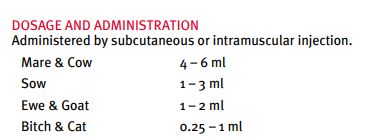Oxytocin during whelping
In case of bitches in labour where things seem to be stagnating, many veterinarians prescribe oxytocin as a very common thing. The opinions about the ease with which it is used vary a lot. Time to take a closer look.
Many breeders have oxytocin in the fridge and ready for use when a bitch is due to whelp. It has also been very common for years that bitches have a shot of oxy after or during delivery. Comments on this are increasing. Time to raise the question: what is oxytocin?
This article is a premium article, available to subscribers of our magazine and website subscribers. Subscribers can read the remainder of this article.
Do you want access, please check here for possibilities
Oxytocin is the hormone the body produces during delivery, but it is much more than that. It is also a neurotransmitter with a wide range of functions. Oxytocin is mainly known as an important hormone, active during the delivery of mammals. That means human delivery as well as canine ones.
Oxytocin reduces stress, helps to suppress anxiety and stimulates the mechanism of defense.
During whelping, oxytocin is of great importance. The body itself is producing it and it causes the contractions of the muscle tissue of the uterus during whelping.
The production of oxytocin during a delivery is found to structurally change the hormonal system. That is the reason mothers are more susceptible to babies crying after their first delivery, something that applies to both humans and animals. Oxytocin also stimulates the production of milk, thus allowing the physical reflex for the milk to start. So all in all this is an important hormone.
Veterinarians (and also humane doctors) often summarize the effect quite briefly: oxytocine induces contractions. And yes, it does. But what matters a lot more is how this artificial hormone is used. In dogs it has been customary for many years for a bitch to be given a shot of oxytocin after delivery and if the puppies were not thrown fast enough, she would get a shot during delivery as well. The question to ask here is: how wise is it to do so?
In women cardiac monitoring for mother and child is required when oxy is given. In dogs, not even the use of a stethoscope is advised.
In human deliveries, oxytocin is given only when there is cardiac monitoring for both mother and child. The reason for this is the responses of the body to the artificial variety of oxytocin. A natural contraction is a peristaltic movement, in which the uterus contracts from top toward bottom in an undulating movement, thus pushing the fetus outwards. When caused by the artificial variety, contractions look very different. The uterus then contracts as a whole. With multiple administering, uterus cramping without in between relaxing often occurs. The consequence can be that any pups lying above the cramped parts will not be able to descend anymore. Therefore artificial oxytocin is not without risk.
In women cardiac monitoring for mother and child is required when oxy is given. In dogs, not even the use of a stethoscope is advised. Oxytocin was and is often given to bitches without actually thinking about it. But even more striking is the dosage. When a bitch receives oxytocin from a veterinarian, she is almost always asked about the weight of the bitch. But the leaflet teaches that the weight is absolutely irrelevant. Oxytocin is not related to weight. It triggers a specific response in the body, regardless of whether we are dealing with a chihuahua or a mastiff.

So, the package leaflet of Oxytobel teaches us that side effects only occur with overdose. This means that if oxy is given on weight, chance of overdosing are huge! Because how much of this stuff can a dog actually take? Let’s check the leaflet once more. It tells us a dog can have 0.25 to 1 ml. Not per a certain weight but per animal, regardless its size. So please try and get through your head what these quantities say and realize most bitches get a lot more.
So we are talking overdose. Apart from the fact that this may not be very pleasant for the bitches, it will also rise the risks of side effects. Which are? How about:
- Short-term vasodilatation (blood vessel dilation) and drop in blood pressure
- Water retention (retaining moisture)
- Hyperstimulatio uteri causing prolonged and often occurring contractions of the uterus (prolonged and severe contractions).
- In case of a cramp condition of the uterus, the oxygen supply of the fetus can be jeopardized.
- Influencing the fetal circulation.
In fact, this means that we are dealing with a very heavy drug that is generally given in quantities that are well over the recommended dose, with all the consequences that this entails.
Anything that stimulates contractions of the uterus in such a way that the intervals between them are shortened thereby involve risks for the fetus. There is a high risk of oxygen deprivation in the fetus, which can cause brain damage and other neurological damage. And that is apart from the fact this drug can be given by a breeder. And how could a breeder that is not a vet check dilation? The leaflet says:

The exact size of those risks is unknown because there is no country where side effects have to be reported. And apart from that, deceased pups are rarely, if at all seen as a side effect of the given oxytocin.
In a normal, natural delivery the contractions build up, they increase in intensity, they rise further and further until they lead to actual pushing, after which the puppy is born. There is a natural rest between each contraction in which both mother and pup can rest and gather their strength for the next woe. When oxytocin is given, this natural cycle is lost and the contractions are unrelenting, one after the other, without rest. Unless there is no other option, every veterinarian should therefore argue for a whelping to be as natural as possible, without oxytocin. And if it is given, then at least in the right, low dose!
Something to support contractions is calcium. It is important not to supply extra calcium before the whelping, because the body will then reduce the natural production. And during delivery that production is really needed! Supplying calcium during delivery however is a good idea: the calcium will work together with the calcium already present in the bitch to ensure good, strong contractions that naturally expel the puppies. Calcium can be given in various forms: puppy milk, vanilla ice cream, yogurt or curd cheese. For some extra energy sugar can be added as well. A natural remedy that is often very effective and does not involve any risks for mother and pups.





